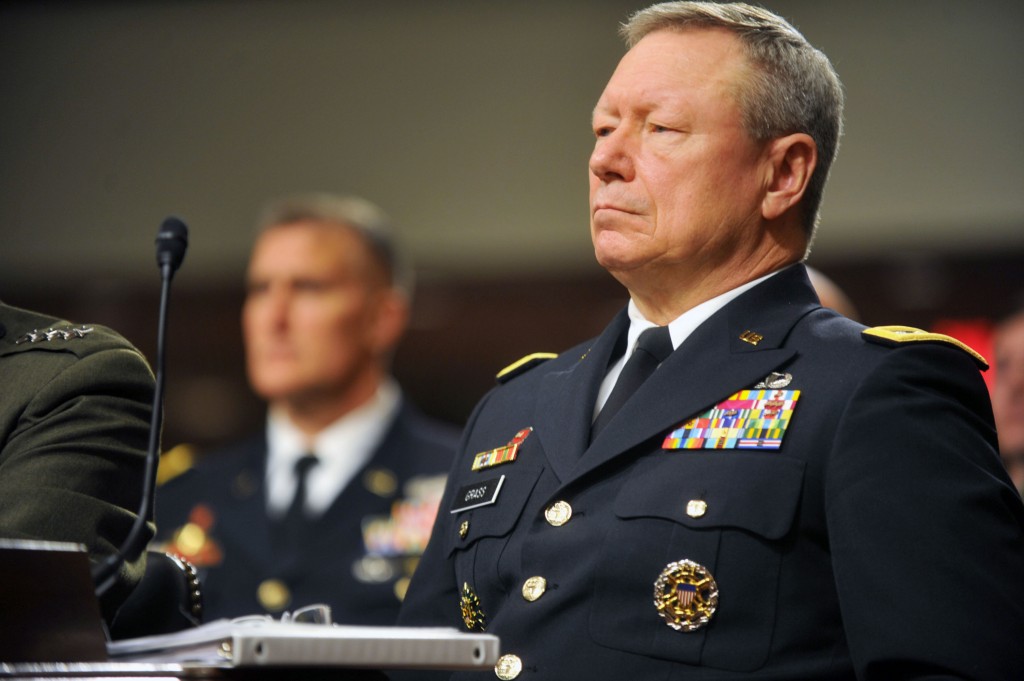Gen. Grass: Budget Deal Gives Guard, Army Time To Compromise
Posted on

The chief of the National Guard Bureau, Gen. Frank Grass, testifying to Congress last year on the impact of sequestration.
As budgets tighten, will the National Guard and the regular Army go to war? Not if Gen. Frank Grass, chief of the National Guard Bureau, can help it. Peppered with questions about the conflict today at the National Press Club, Grass carefully redirected almost every one. In fact, he said, December’s last-ditch budget deal to delay sequestration gives the two components time to resolve the potential conflict with a painful but rationally agreed-on compromise.
“We’ve got some relief here for a few years, so what we don’t want to do is rush into failure,” Grass said. “We’ve got some relief with the $22 billion added [to the defense budget for fiscal year 2014] and the $9 billion added [for 2015], and that gives us a few years to look at this.”
If it does come to an all-out funding fight, said Grass, “we could win the battle and lose the opportunity to train our folks, because the training infrastructure comes from the Army and the Air Force.” So does the vast bulk of the funding that keeps procurement programs alive for the Guard to piggyback on at a low marginal cost. “As the active component loses money,” he said, “we won’t be able to modernize, we won’t be able to send pilots to the schools[,] we won’t be able to get people into basic training and advanced schools.”
So the Guard has an enlightened self-interest in not savaging the active-duty budget. But, asked Press Club president Angela Greiling Keane, isn’t the budget ultimately a zero-sum game? Hasn’t the Army Chief of Staff, Gen. Ray Odierno, explicitly said the active duty force has borne the brunt of the cuts so far and the next round will have to fall heavily on the Guard?
Grass paused for a few long seconds. “This is the hard part. This is the hard part,” he said.
“There’s one defense budget so we all have to work off that,” Grass acknowledged — before quickly turning the subject to how the Guard must accept its share of cuts: “I tell the adjutants general [the state Guard commanders] that we’re not immune. Our appropriations are not immune from the Budget Control Act, so as long as we have a Budget Control Act we’re going to take reductions.”
(The 2011 Budget Control Act laid the legal foundation for the automatic budget cuts commonly called sequestration).
“What is the right balance?” Grass asked. “We know we can take some reductions and maintain a quality force in the Guard and pay the Budget Control Act bill.”
“What we’ve worked on is a proposal with the adjutant generals that shows how we could pay those bills,” he said. “Those are the numbers we’ve been working [on] with the Army and the Air [Force]. I think we’re in a pretty good place with the Air. We’re still working through on discussions with the Army,” he admitted.
There is a vital role for both, he emphasized. Active-duty troops work for the federal government full-time and are “24-7 ready to go,” Grass said, albeit at great expense in pay and benefits. The vast majority of Guard and reserve troops have civilian jobs and train part-time — they’re essentially on retainer — so they take some time to mobilize. While Air Guard units can be ready to fly in 72 hours, Grass said, Army units not only take longer but their deployment speed may well slow down as funding dries up.
While smaller, specialized units can get going in a few weeks, larger units with many different types of troops take longer: Currently, “in 50 to 80 days we’ll have a brigade ready to go,” Grass said. “Now, some of those brigades are harder to train than others,” especially heavy mechanized units with lots of armored vehicles. “The worst case, especially as we go down and resources are dwindling, will probably be 80 to 110 days.”
That said, Grass did politely refute Gen. Odierno’s statement that the Guard only trains 39 days a year. The traditional one weekend a month and two weeks a year hasn’t held true for a long time, Grass said: “I did train 39 days a year for a few years in about ’71 and ’72. Once you become a leader, even as a sergeant, you may get paid 39 days a year, but I would tell you those Guard men and women are in the armory once a week [or] twice a week.”
“We’ve got to be ready to move” whenever the regular active-duty military needs reinforcements, Grass said. “That means being organized, trained, and equipped the same. And I can honestly tell you today our readiness is higher than it’s ever been in the Army and Air National Guard, and we are organized trained and equipped at a level higher than I’ve ever seen it in my 44 years of service. That’s because of a lot of great investment by the nation throughout the war. The real challenge is how your balance that now in this fiscal environment and not lose that edge.”
“However the Amy looks or however the Air Force looks, we’ve got to be interchangeable,” Grass said. “We’ll never be identical to them. We’re not going to be and we’ll not try to be. And they will never be identical to us because of that homeland mission where we roll out the gate [to respond to local disasters] — but we’ve got to be complementary.”
Subscribe to our newsletter
Promotions, new products and sales. Directly to your inbox.
